It’s a device that sends electrical pulses to your body through sticky pads.
Although it sounds like magic, it’s not.
A transcutaneous electrical nerve stimulation (TENS) unit is the most common form of electrotherapy for managing various types of acute and chronic pain. TENS units are small, battery-powered devices that administer mild shocks through sticky tens unit pads (also called electrodes) that connect to the skin. These electrodes connect to the TENS unit through lead wires. However, wireless TENS units have become popular.

TENS units send electrical pulses to the skin to stimulate the body’s nerves. The TENS unit relieves pain through two methods, pain gating and the release of endorphins.
In short, it helps you relieve pain without the use of or in unison with pain medication.https://www.youtube.com/embed/HjOFM50_Kno
To understand pain gating, we must first understand how pain works. Pain is essentially a warning system in the body that lets your brain know something is wrong. Think of it as the body’s car alarm when something’s not right. When experiencing pain from an injury, pain signals are sent to the spine, which is sent to the brain. The brain then decodes them into the feeling of pain.
Pain gating is a theory created by Ronald Melzack and Patrick Wall in the early 1960s. Pain gate theory explains how nerves perceive pain, and touch impedes that perception. Essentially, the theory states that there are “nerve gates” at the end of your spine that control if pain signals are allowed to pass to the brain to be decoded. There are two types of nerve fibers, small (pain fibers) and large (fibers for skin senses such as touch and pressure). These fibers carry information from the area of pain to the spine.
When small fiber activity is more abundant than large fiber activity, the pain gate is open, allowing pain to be transferred to and decoded by the brain. However, the pain gate is closed when large fiber activity is more robust than small fibers. This does not allow pain nerves to be sent to the brain (i.e., no pain!).
Pain gate theory explains why we rub or shake injuries after they occur. By rubbing or shaking the injured area, we’re creating more large fiber activity, which diminishes small (pain) fiber activity, thus reducing the sensation of pain.
A TENS unit activates large fibers to overpower small fibers by creating a tingling or massaging sensation to close pain gates. The tingling/massaging sensation doesn’t allow pain fibers to transmit painful feelings to the brain. In short, the pain gets temporarily blocked.
Endorphins are one of the body’s natural chemicals known as neurotransmitters. Endorphins are released when the body is in pain or stress is occurring. Endorphins help reduce pain and lead to feelings of euphoria, modulation of appetite, the release of sex hormones, and enhanced immune response.
TENS units cause the body to release endorphins by sending electrical pulses to the body, the same effect that medicinal drugs have but without the risk of dependence or dangerous side effects.
TENS therapy is one of the most used forms of not just electrotherapy, but pain management for chronic and acute pain. Before TENS 7000 was an OTC TENS unit, it was the most prescribed TENS unit by professional doctors and physical therapists.
It may be a shock that there has been no conclusive research or clinical trials determining if TENS therapy is a reliable pain relief treatment. However, there have been tests done stating a positive result of pain relief. Not to mention, thousands of positive reviews have been left.
TENS therapy is nothing new; it’s been used for quite some time now. We’ve broken down a brief period to help you understand not only how old TENS therapy is, but how it has evolved.
Pain relief from TENS therapy has shown varying results with aid lasting as short as 5 minutes and up to 24 hours. There’s no definite answer as to why this is, but one hypothesis is that pain relief depends on the pain type as well as the level of pain.
Acute pain is going to require less treatment compared to more severe and chronic pain types. Tips for consistent pain relief with TENS therapy include continuously using the TENS unit as well as changing the electrode positions and intensity of the treatment.
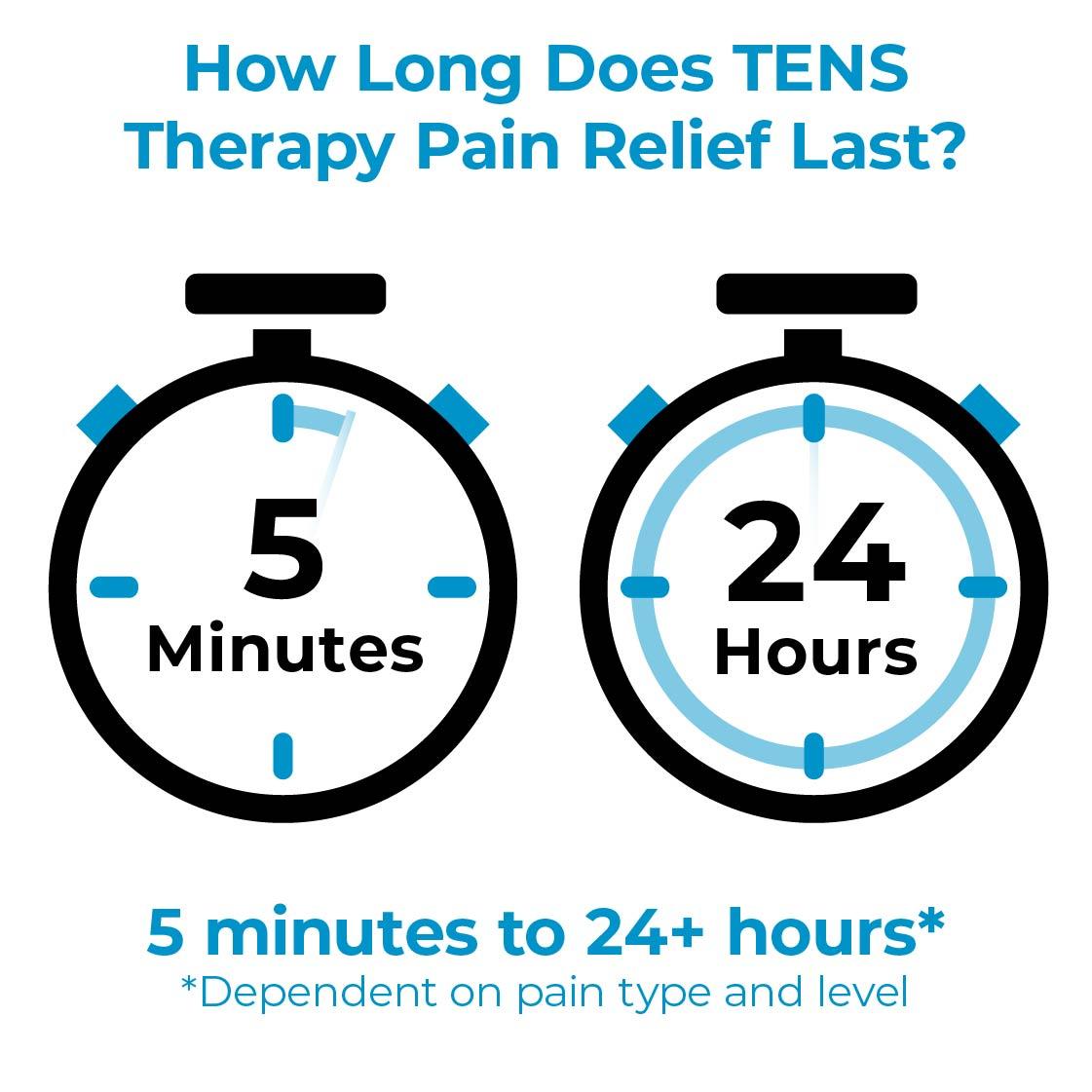
TENS units offer many benefits such as drug-free pain management, customizable treatment, non-expensive pain relief compared to traditional therapy, and more! We’ve compiled and elaborated on the many benefits of TENS units below:
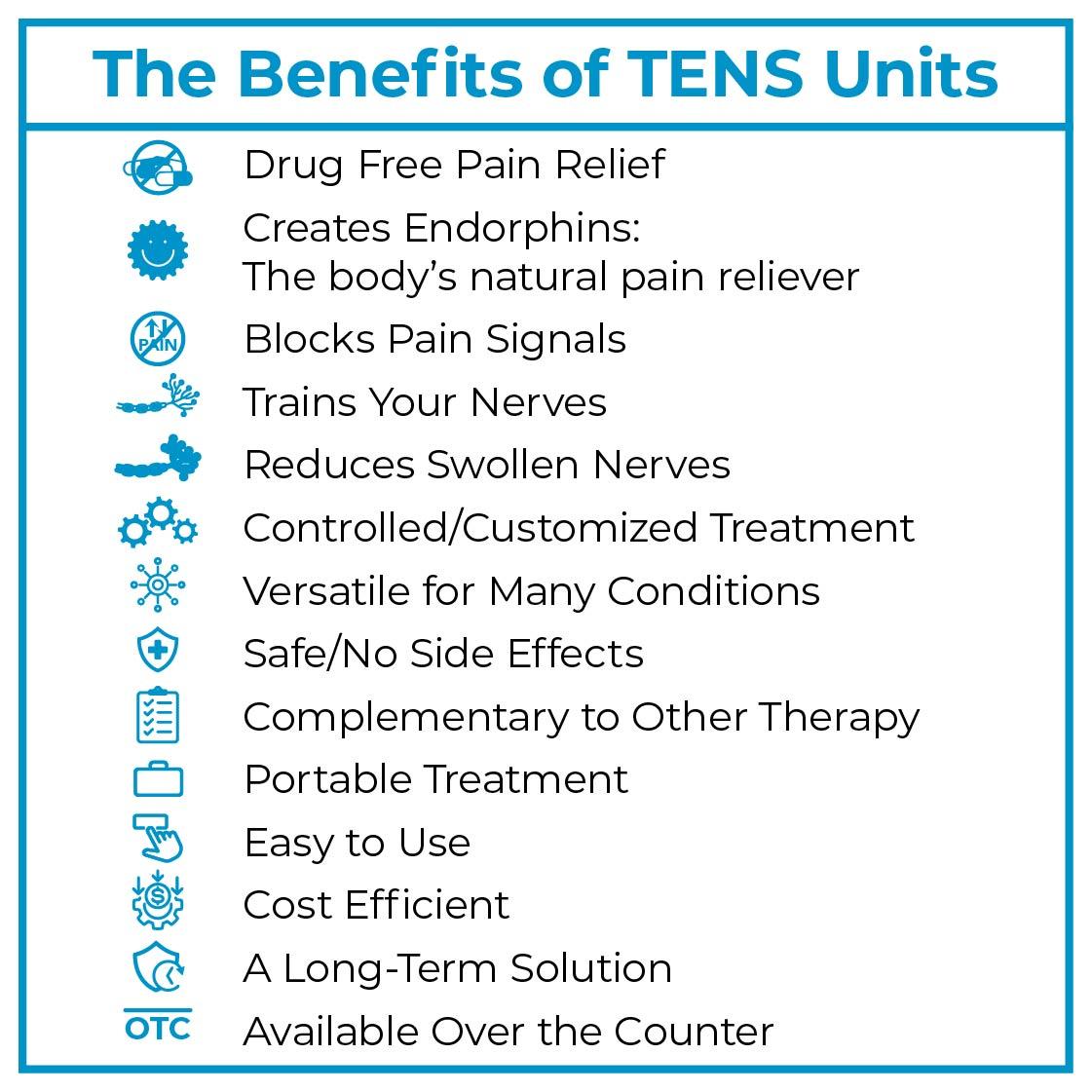
At the height of the opioid crisis, TENS therapy serves as an effective drug-free, all-natural pain relief solution without the side effects of prescription drugs.
Endorphins are the body’s natural pain reliever. TENS units cause the muscles to twitch, which results in the release of the endorphin hormones.
Because of the pain gating effect, TENS units help reduce pain by not allowing pain signals to get to the brain.
Chiropractors have found that continuous treatment over long periods can aid in changing nerve behavior to stop pain signals to the brain.
Muscles swell as a reaction to protect the injured areas. TENS units help reduce swelling by blocking pain signals which cause the body not to react by swelling up.
When it comes to prescription drugs, the user has no control over the strength of the treatment. Because TENS units feature different intensity levels and modes, users can customize their treatment based on pain level.
TENS units have been proven through research and user experience to work for different conditions such as arthritis, back and knee pain, and more. It works great for both chronic and acute pain.
TENS units are an excellent pain relief solution because of their safety. There have been no reported instances of significant injury from TENS therapy. Because their shock level is low, injury from electrocution is nearly impossible.
Because of its ease of use and non-invasive nature, TENS therapy works great alongside other therapy methods, including physical therapy, pain medications, and more.
One of the highest compliments that TENS therapy gets is the ability to use it almost anywhere. Because of its non-invasiveness and subtleness, users can get pain relief in public without being noticed. Electrodes stick to the skin under clothes while the TENS unit can be put in their pocket or (if it has a belt clip) clipped to their belt.
TENS units are super easy to use. So easy that women giving birth reported a positive experience.
Prescription drugs and trips to doctors and physical therapists can rack up bills. TENS units offer an affordable solution that won’t break the bank. TENS unit prices range from $20 to $200 depending on features and strength.
TENS units offer a long-term solution with little or no side effects and can be used continuously as a monthly, weekly, and even daily pain relief tool.
Because you don’t need a prescription for OTC TENS units, waiting to see a doctor or physical therapist is not required. It is recommended that you see a doctor though to find out if TENS units are a possible solution for your condition.
Because of a TENS unit’s versatility and customizability, they’re the perfect solution for multiple types of pain in different areas of the body. They offer targeted pain relief since you’re able to place the electrodes on and around the area in pain. Below are the many ailments that TENS units help relieve.
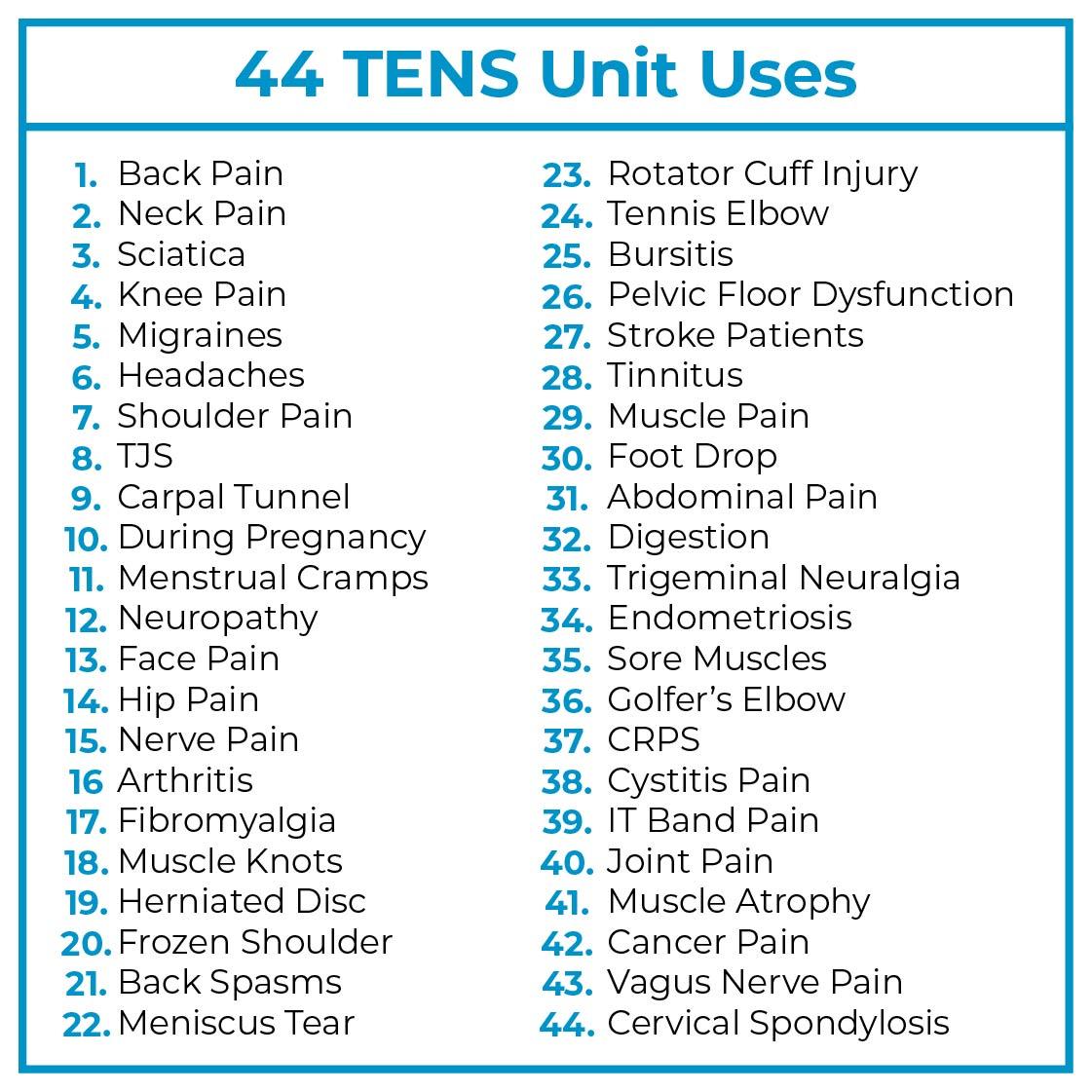
There have been quite a few mixed reviews of the effectiveness of TENS units for upper and lower back pain. One analysis in 2014 found positive trends in TENS treatment for chronic back pain treatments. However, another study from The New England Journal of Medicine found that TENS therapy acted as a placebo, but the benefits didn’t go further. There have been thousands of reviews from users stating pain relief from their TENS units. Many factors play into the effectiveness of electrotherapy, including:
TENS units are not recommended to be used on the neck because of the sensitivity of that area. However, NHS has recommended using TENS units on the neck with the proper placement. We recommend placing electrodes right below your neck, on the upper back. The electrical impulses will travel to the neck for neck pain relief.
Because Sciatica is a nerve-related pain condition, TENS units work excellently in reducing sciatica pain. Clinics often carry TENS units to assist patients in reducing sciatica pain. TENS units work great for sciatica pain because they can target the specific problem area.
Because knees absorb much of the shock from walking and other physical activities, they’re most susceptible to injuries, including sprains, arthritis, and swelling. Studies have shown that TENS therapy helps with swelling, osteoarthritis, and post-surgery pain.
Migraines are another nerve-related condition that results in pain. Since TENS units work by blocking pain nerves, they help treat migraines. A study at Baqiyatallah University of Medical Sciences in Iran and The Journal of Headache and Pain found that people with migraines had less pain after using TENS therapy.
Although there are no definitive studies proving TENS as a credible solution for shoulder pain, many reviews have been posted. A 2001 study showed that TENS therapy helped movement in patients recovering from a shoulder stroke.
A 2017 study found TENS to treat the pain related to TMJ effectively. Another study found that TENS therapy reduced pain more effectively than Naproxin, a common painkiller used to treat TMJ.
A study conducted in 2010 found TENS therapy to reduce pain related to Carpal Tunnel Syndrome significantly. The research looked at 20 female patients to show how TENS treatment would impact cortical activations.
While NHS advises against using TENS therapy in the early stages of pregnancy, a study showed that pregnant patients had no adverse side effects. It is strongly recommended to consult your doctor when considering electrotherapy for pain relief while pregnant.
TENS treatment has been shown by research to effectively reduce the pain accompanied by period pains. The study looked at the pain levels of 122 patients and how TENS therapy affected it when applied.
The Foundation of Peripheral Neuropathy recommends electrotherapy as a complementary treatment alongside other therapies. A study found TENS therapy to be effective when treating Diabetic Peripheral Neuropathy.
While it’s highly advised that TENS therapy should never be used on the face, users have reported positive facial pain relief.
Studies found positive results for TENS therapy as a source of pain relief, with studies looking at posttraumatic hip pain and hip flexor pain. Not only this, but users have reported positive results and highly recommend it as a source of hip pain relief.
TENS therapy involves blocking pain nerves from reporting pain to the brain, making it a perfect candidate for nerve pain relief. The Brain and Spine Foundation also recommends TENS treatment as a pain relief option. Studies are inconclusive but have found TENS treatment to amplify the effectiveness of pain medications such as Pregabalin.
TENS treatment for arthritis is recommended by Arthritis Research UK but clarifies that results are mixed depending on the levels and types of arthritis. A 2015 study showed that the overall success rate for arthritis pain relief with TENS therapy was 50%.
There haven’t been many studies conducted on TENS therapy for Fibromyalgia. Existing research does show that TENS units have a calming effect on the central nervous system. This calming effect reduces Fibro pain considering the condition causes a hyper-sensitized central nervous system.
Muscle knots result from the body’s natural pain mechanism to protect the injured area. Because TENS therapy blocks pain receptors, swelling is reduced, and muscle knots are decreased. Some findings have shown electric muscle stimulation to be even better at relieving muscle knot pain than electrical muscle stimulation.
Not only does NHS recommend TENS therapy for herniated disc pain relief, but studies also found it to be the most effective treatment option. The Herniated Disc Authority also recommends TENS for daily pain treatment.
While there is no singular approved treatment for frozen shoulder, The Oxford Shoulder and Elbow Clinic suggest it as a treatment option. A 2011 study found TENS to effectively improve shoulder pain and increase range of motion.
Physical therapists and physicians highly recommend TENS therapy to treat muscle spasms. NHS reported that TENS treatment helps with muscle spasms caused by arthritis, period pain, sports injuries, and more.
Physical therapists such as Physio Active recommend electrotherapy as a treatment method for meniscus tears. After using a TENS unit, users have reported a positive experience and reduced pain from their injury.
TENS units are a standard tool used for those suffering from nerve damage. Few studies have been conducted, but one study took rats with nerve injury and found TENS to reduce pain. Because of how TENS works, many chiropractors believe that TENS helps retrain nerves, which causes them to stop sending pain signals to the brain.
There have been no conclusive studies proving TENS as a helpful pain relief tool for rotator cuff injuries. Many physical therapists do recommend it as a treatment method. This type of injury is in an awkward part of the body, making TENS a viable option because of the ability to place electrodes easily and target the pain.
TENS therapy for tennis elbow is a controversial topic. Some studies have found it to be ineffective in treating pain, while others show that it has. To make matters more interesting, users have reported positive results when treating pain from tennis elbow.
Because Bursitis is a condition related to inflammation, Cleveland Clinic recommends it as a treatment option. Users have reported positive results with pain reduction from the condition.
Because Pelvic Floor Dysfunction is a condition related to muscles, TENS effectively treats related pain. A study concluded that TENS effectively treats pelvic pain associated with the condition.
A study on the effectiveness of TENS on stroke patients found the treatment method improved walking capacity and reduced spasticity.
A research study in the US National Library of Medicine found TENS effective in patients with ‘typewriter’ tinnitus. Another study showed the treatment helped patients whose tinnitus worsened with their neck movement.
TENS therapy is a standard and highly used treatment method for muscle pain. Recommended by the NHS, countless studies show it to be an effective way of treating muscle spasms and knots.
Because Foot Drop is a condition that causes muscles in the foot to be weak, TENS therapy is a recommended treatment option. The treatment method helps strengthen the muscle to reduce foot drop. Users have reported food drop pain relief from using TENS units.
Studies have typically shown that this treatment method has helped reduce abdominal pain. One study found that TENS therapy effectively treats abdominal pain for at least six months with no placebo effect.
As weird as it sounds, a study found that TENS therapy helps with digestion by increasing the salivary flow, a critical component that helps digest food.
The study used 50 subjects to look at how the application of TENS units impacted salivation. It concluded that TENS aided production by increasing it by 37% amongst 43 of the 50 subjects.
A study in 2011 found TENS therapy to be a helpful source for treating pain related to TN with no adverse side effects.
A study of 22 women found TENS to treat pain related to endometriosis effectively.
TENS units create a massage-like stimulation on sore muscles, helping them relax while reducing pain/soreness. A study went further to prove that TENS therapy is effective in lowering onset muscle soreness after eccentric exercises in combination with cryotherapy.
While there are little to no studies on the effectiveness of TENS on golfer’s elbow, health clinics recommend it as a treatment.
NHS does recommend TENS as a pain management solution for CRPS when accompanied by other pain treatments. A study in 2016 did find that TENS, when added to a physical therapy regimen, aids in clinical recovery.
The Interstitial Cystitis Association and The National Institute of Diabetes and Digestive and Kidney Diseases recommend TENS to treat IC pain.
It’s common for physiotherapists to recommend TENS as a treatment for IT band pain. The treatment method is accompanied by ice and stretching for optimal treatment results.
TENS therapy is proven to be a helpful source of joint pain relief. Many users describe a positive experience, and reports show a successful reduction of pain when used.
Research has found that TENS increases muscle town in patients that suffer from muscle atrophy. However, electrical muscle stimulators (EMS) are commonly used to achieve this result.
TENS therapy is recommended as a pain relief source by well-regarded sources such as Macmillan Cancer Support. A study from the Department of Anesthesiology showed that TENS effectively reduced cancer pain in 69.7% of patients over two months.
While some have reported TENS as an affordable option for treating Vagus Nerve pain, the results are mixed.
Some studies show data showing TENS as an effective and safe form of treatment. The best TENS unit for Vagus Nerve stimulation offers a customizable treatment to allow users to control the pulse width, the pulse frequency, and the on/off duty cycle.
A study found TENS treatment helpful in treating neck pain from musculoskeletal disorders.
One of the most popular TENS unit topics is how they are different from EMS units? EMS stands for electrical muscle stimulation. If you were to hold a TENS and EMS unit side-by-side, you wouldn’t be able to tell them apart. Both use electrodes, have a similar button layout/functionality, and deliver electrical impulses to the user.
The difference between TENS and EMS units is what they’re used for. TENS units relieve chronic and acute pain such as arthritis, back pain, labor pain, and Sciatica. EMS units are used as a part of training programs for strengthening muscles, rehabilitation, relaxing muscles, and cosmetic muscle toning.
There are TENS EMS combination devices available for those looking for both pain relief and a tool for muscle strengthening. These do require a more substantial initial investment but can be worth it.
Who a TENS unit is for: Someone looking for a natural solution to chronic or acute pain.
Who an EMS unit is for: Someone looking to build muscle as part of a training program.

Some TENS units do require a prescription, meaning they have to be prescribed by a doctor to use. Over-the-counter (OTC) TENS units do not require a prescription and can be purchased by anyone. Both over-the-counter and prescription TENS units are capable of delivering pain relief. The significant difference lies in the intensity levels and treatment modes.
Most prescription TENS units will offer higher intensity settings and more treatment modes. These units often feature customizable frequencies and wave types to more precisely target pain. OTC TENS units usually only let you increase or decrease the intensity and choose from a few different mode types.

For someone just learning about TENS units as a pain management tool, the terminology, buttons, and various options/treatment modes available on these devices can be overwhelming. We’ve broken down typical TENS unit parameters and language below to help you understand what you’re looking at when shopping for TENS units.
Most TENS units come with preset “modes” that you can select when using TENS therapy. These modes control the pulse duration, pulse rate, timer, and intensity of the pain treatment.
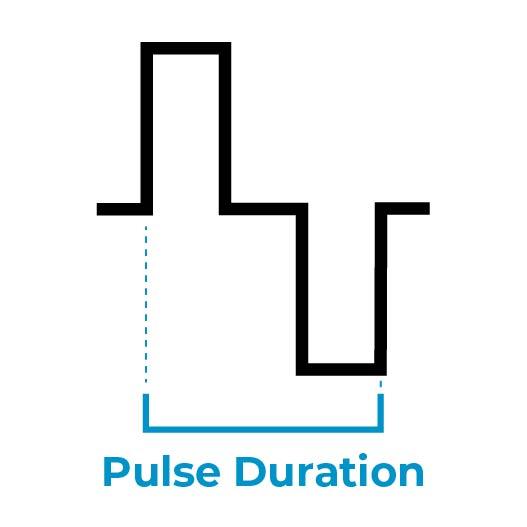
The pulse duration is the length of the pulse that the TENS unit administers. A wider pulse duration means stronger stimulation from the TENS unit. Your TENS waveform selection will be something you’ll want to continue to test out based on how your body reacts to the treatment.
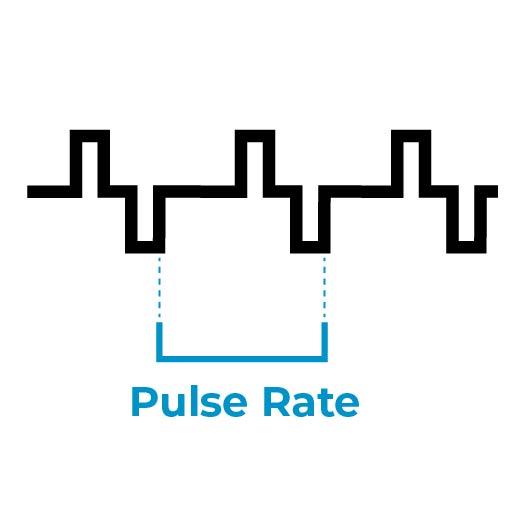
The pulse rate is the rate at which pulses are sent from the TENS device. Pulse rates are registered in hertz or pulses per second. The pulse rate chosen depends significantly on the electrode placement.
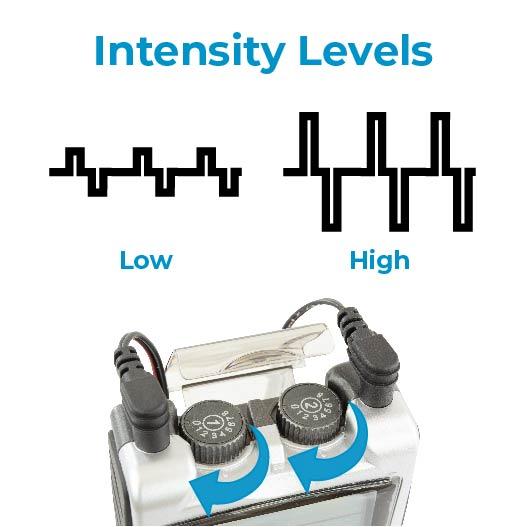
The intensity level is the level of shock administered by the TENS unit. The intensity level is measured in mA, with most TENS units ranging from 0 mA to 80 mA, with 80 mA strongest. It’s always important to start with the lowest level when starting TENS therapy and gradually increase as needed.
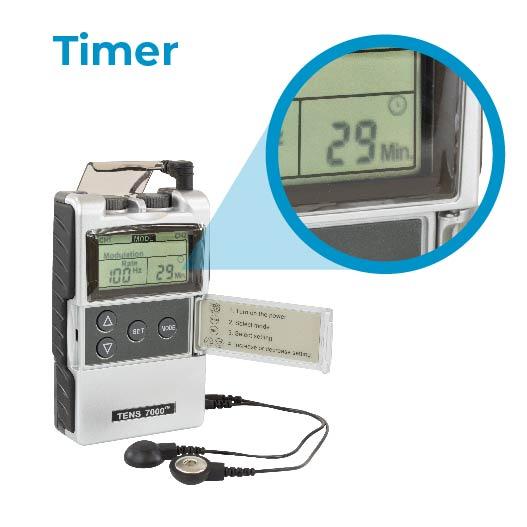
Most TENS units come with preset auto-turn-off timers. Timing on treatment should be used based on the needs of the TENS therapy. Some pain types require longer treatment times to achieve pain relief.
TENS unit channels are the number of lead wires that connect to the TENS unit.
Dual-channel means the TENS unit can connect multiple lead wires to the unit itself. The advantage of dual-channel is that you can customize your treatment with various levels of treatment intensity at once. This feature also allows you to add more TENS unit pads during treatment.
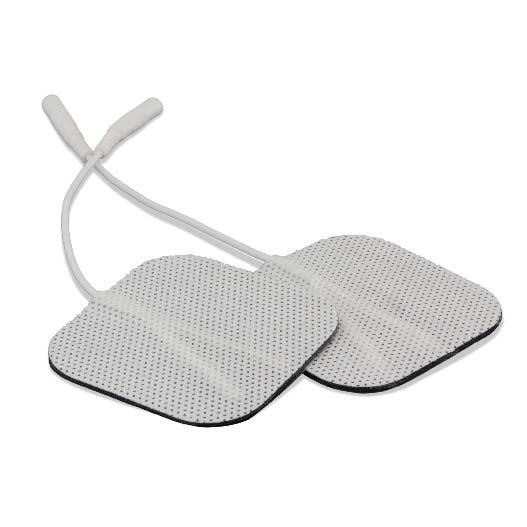
Also called TENS unit pads, electrodes are the pads that attach to lead wires that stick directly to your skin.
These are often reusable but should be replaced once their stick has worn off. It’s essential to change electrodes because once their stick has worn off, proper treatment will not occur. Electrode gels do exist to help keep TENS unit pads sticky.
Various types of TENS unit pads differ in size, materials, and how they attach. Some attach via pig-tail style or snap-on wires.SHOP ELECTRODES
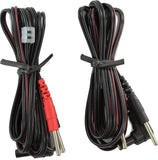
TENS unit lead wires connect the TENS unit to the TENS unit pads to transfer the electric impulses for treatment. Longer lead wires allow for more comfort and ease of use since they can reach further.
Using a TENS unit is quite simple but needs to be used correctly to ensure optimal pain relief. Use these steps on how to set up a TENS unit for guidance:
When it comes to the recommended TENS settings, it’s always best to start on the lowest settings possible and increase the intensity as needed. Make sure you stop at the level when pain is not felt. Be sure not to go too high as the electrical impulses can cause discomfort to the target area. You’ll also want to play with the tens unit frequency and width as this can help create a more custom treatment based on the pain’s location and type.
One of the significant benefits of TENS therapy is targeting particular parts of your body in pain. TENS unit pad placement is critical when getting the best possible pain relief.
When targeting a specific area, place the pads on each side of the painful area. This placement causes the electrical current to pass through the target area. If using four electrodes, place one electrode on each side of the site in a square or diamond shape, depending on the size/placement of the injury.
Each area and pain type is different in regards to TENS unit placement.
It’s essential to clean and dry your skin with soap and water before applying electrodes, and make sure your electrodes are placed flat on the surface.
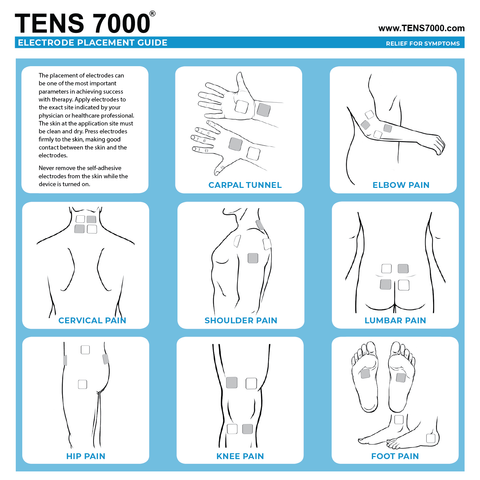
DOWNLOAD OUR ELECTRODE PLACEMENT GUIDE PDF
Because of their sensitivity, there are certain areas to avoid placing TENS unit pads. They include:
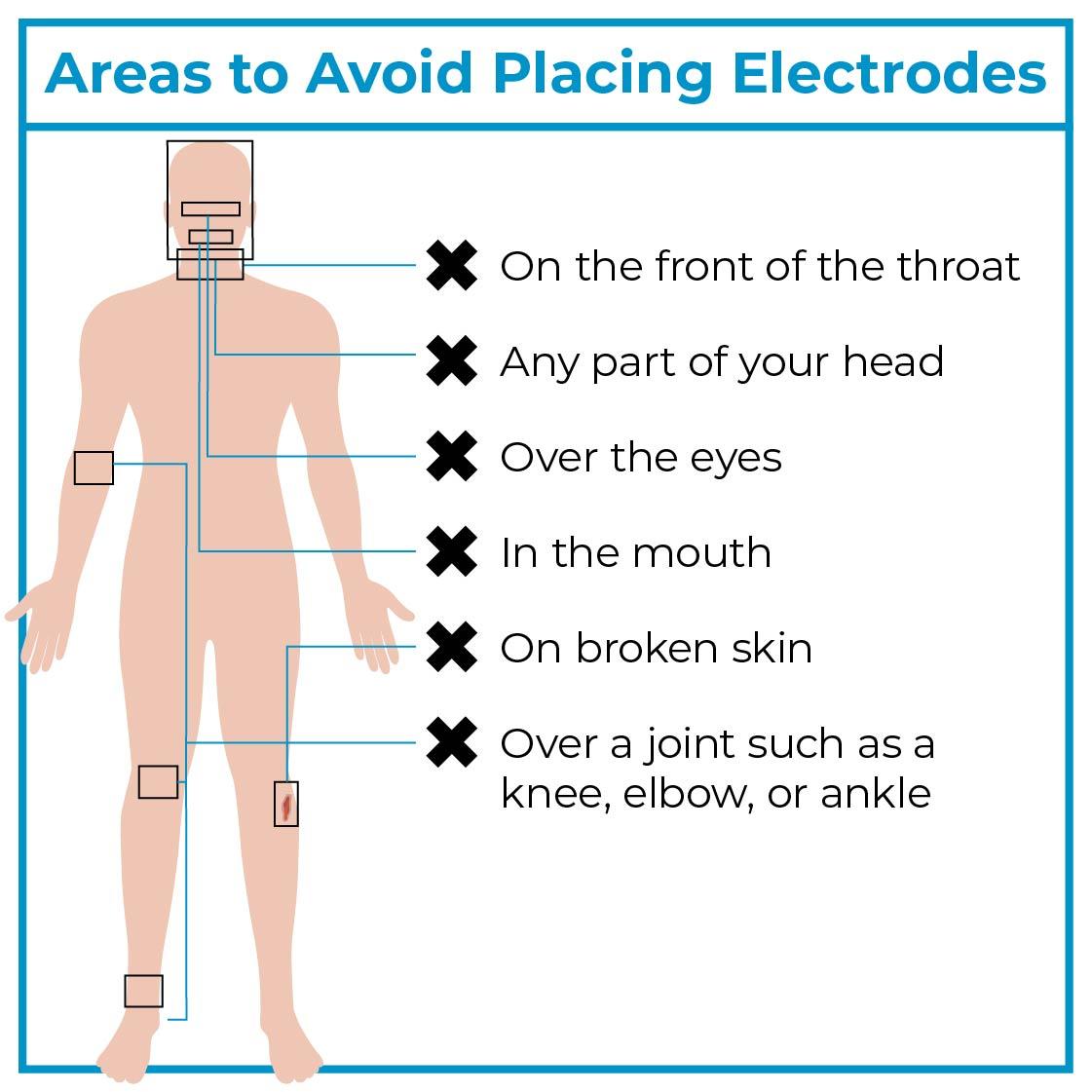
When initially introduced to TENS therapy, safety does come up. After all, you are sending electrical shocks to your body. Anyone would be concerned at first. As unsafe as TENS therapy sounds, it is entirely safe.
There have been no recorded instances of anyone being severely injured when using a TENS unit. The only thing to be careful of is being shocked too intensely from having the intensity level up.
In short, yes. TENS units are very safe and offer a safe and natural solution for pain management. They deliver too weak of an electric shock to cause any significant damage. There has never been any report of significant injury from using a TENS unit, only surprising shocks.
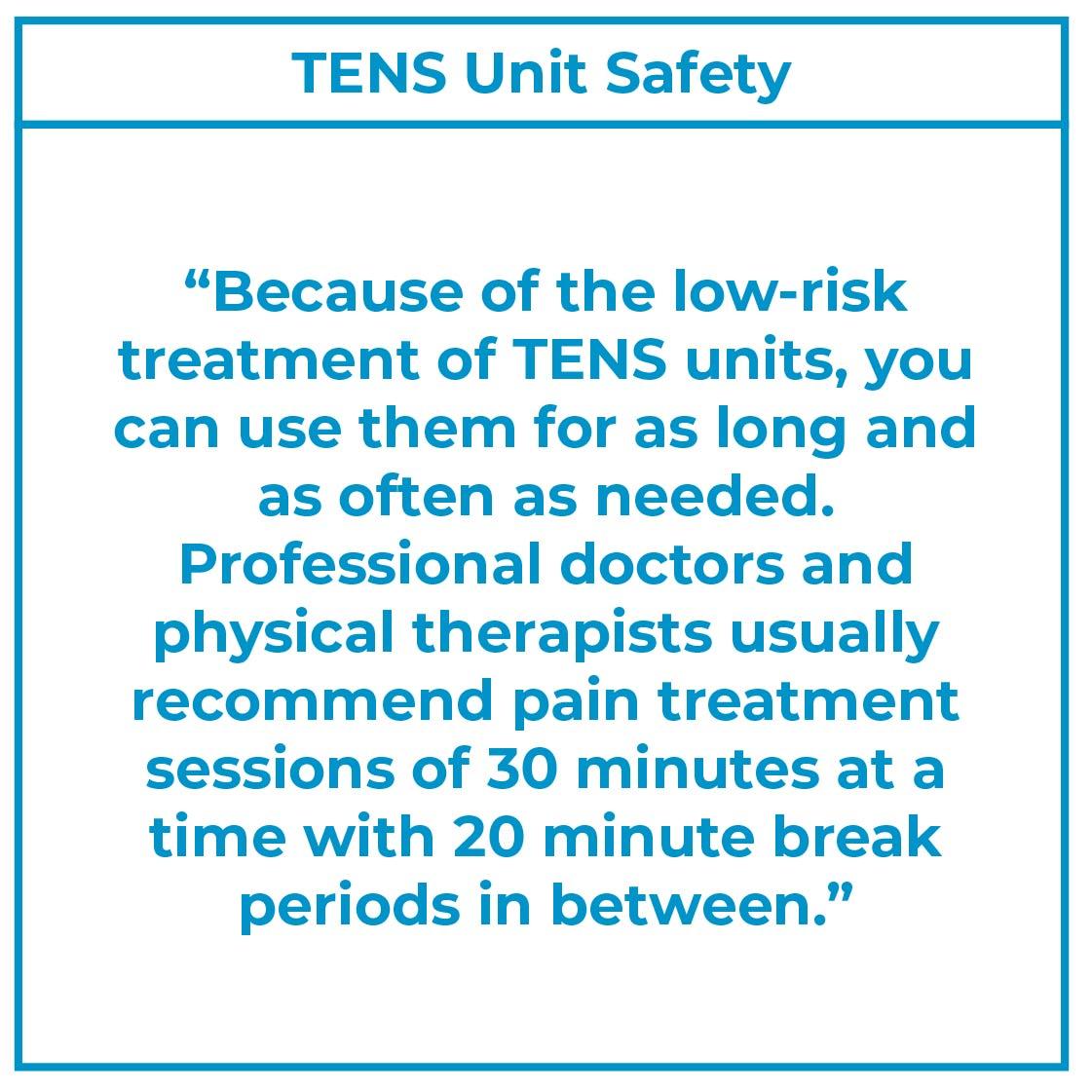
Most people that use TENS units do not experience any side effects. There have been a few instances where people have had allergic reactions to the pads with latex in them. As a solution to this issue, many TENS unit providers now offer latex-free pads.
Because of the low-risk treatment of TENS units, you can use them for as long and as often as needed. Professional doctors and physical therapists usually recommend pain treatment sessions of 30 minutes at a time with 20-minute break periods in between.
If over-used, some soreness may occur while having the settings up too high can lead to uncomfortable muscle twitching. Some have reported a burning sensation on the skin when over-treating the affected area.
We recommend consulting your doctor or physical therapist to see if TENS therapy is right for you. Because you are sending electrical impulses to your body, certain conditions warrant not using a TENS unit. They include:
We recommend you consult your doctor or physical therapist before using TENS therapy as a precaution.
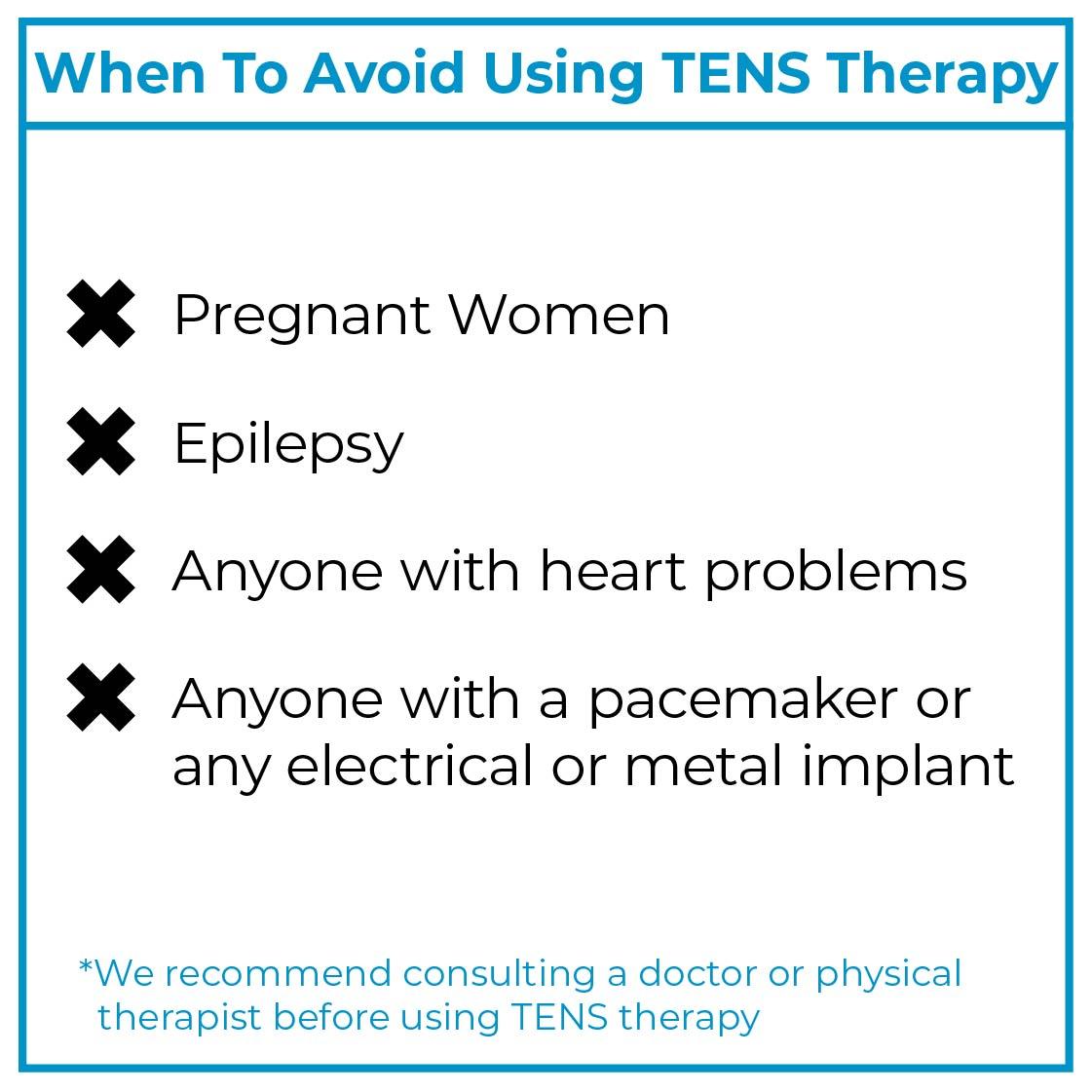
A quick search for ‘tens unit’ on Amazon yields 48 pages with over 1,000 results and 15 brands ranging from $10 to $999.99.
That’s a lot of options.
So many options can get overwhelming, resulting in mental pain accompanying existing physical pain. Below, we’ve highlighted the key differences to consider when selecting a TENS unit.
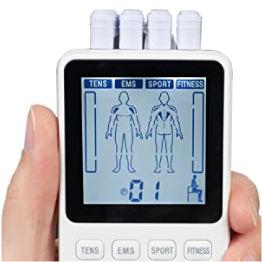
This refers to the number of pads that the unit can have plugged in. More channels equate to the ability to target larger pain areas at once. The different channel types include:
Most TENS units feature dual channels, sufficient for most TENS unit users.
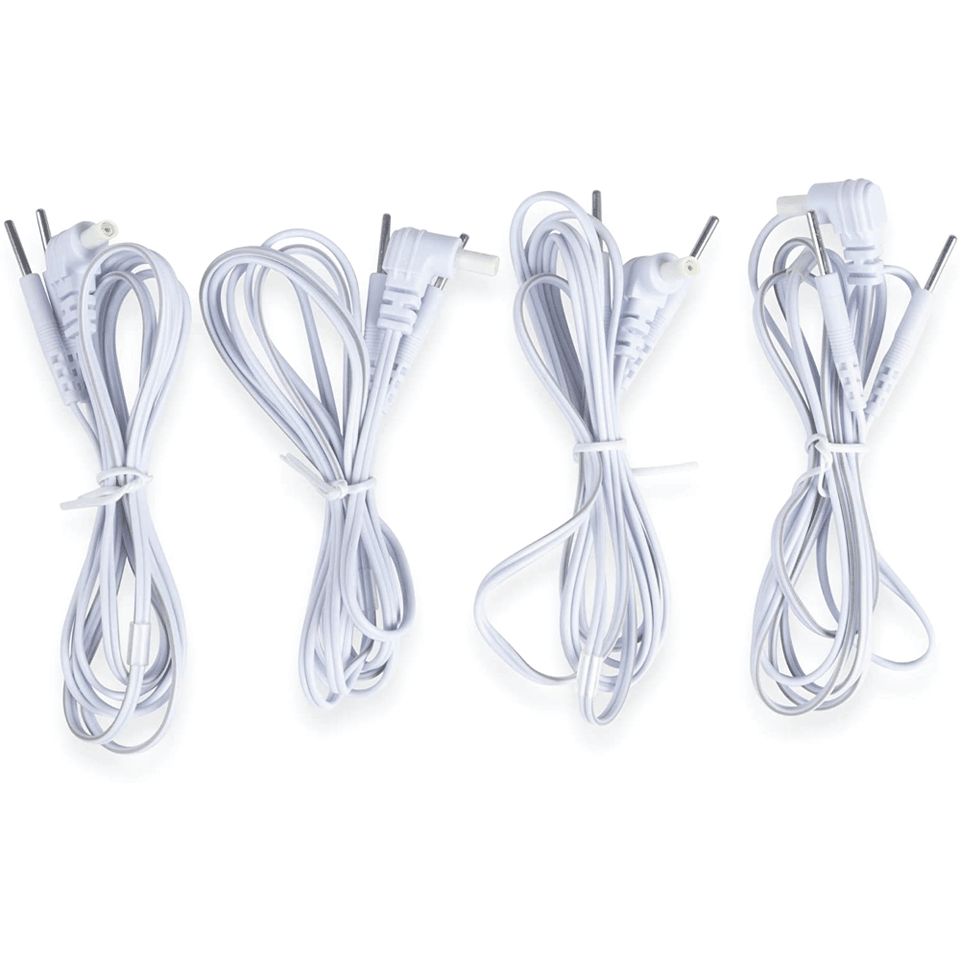
Most TENS units feature electrodes connected to the TENS unit via lead wires. Some feature wireless electrodes, which offer added convenience, so you don’t have to worry about the cables getting tugged on or in the way.
This refers to the preset settings on each unit and automatically sets the pulse duration, pulse rate, timer, and intensity of the pain treatment.
Higher-end (more expensive) TENS units often feature more modes. This feature is excellent if you want a “set it and forget it” approach and don’t care about customizing your treatment.
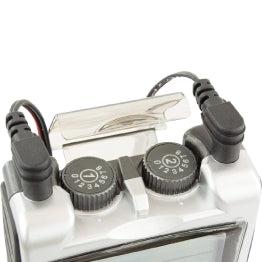
This is important depending on how intense and customized your treatment is. Most TENS units go up to 80 mA while some go up to 100 mA. The stronger the intensity level, the stronger the electrical current sent from the unit.
The timer feature is a major complaint that many TENS units get. Most TENS units have preset timers that automatically shut off and won’t run continuously.
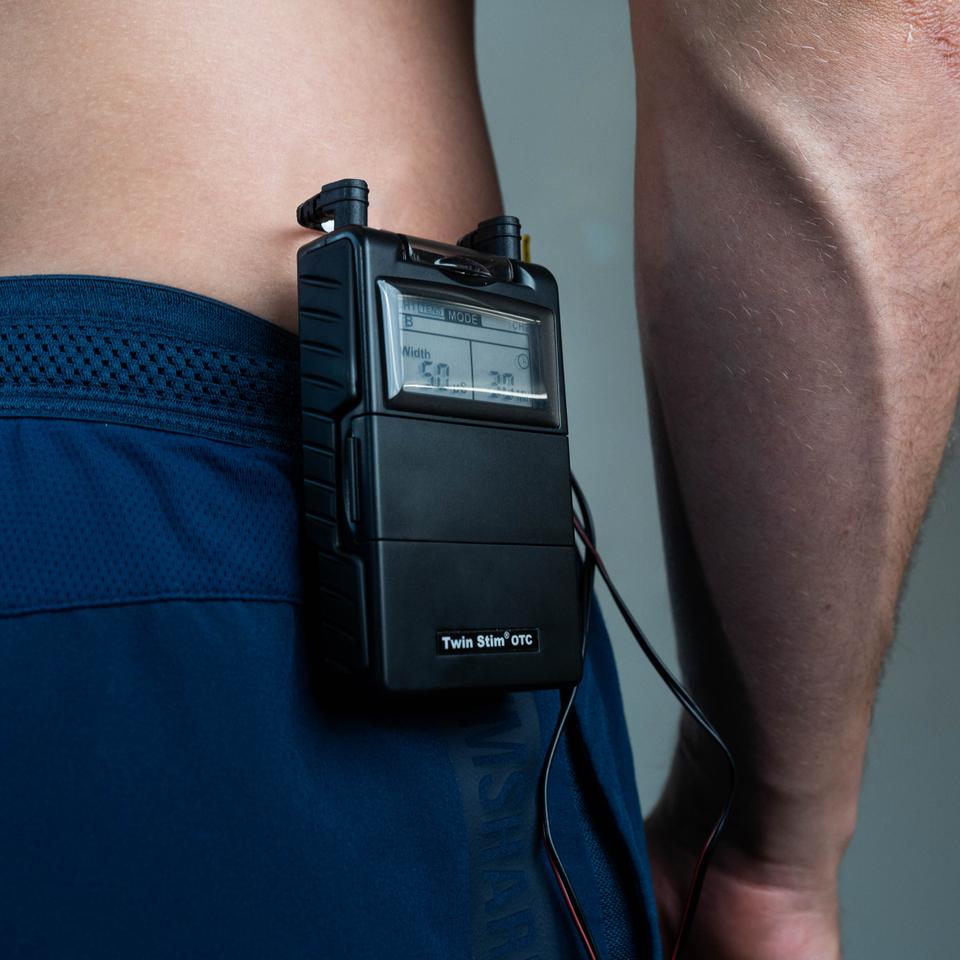
The beauty of TENS units is how subtle they are. Some TENS units are larger and less portable, making them not ideal for “on the go” use.
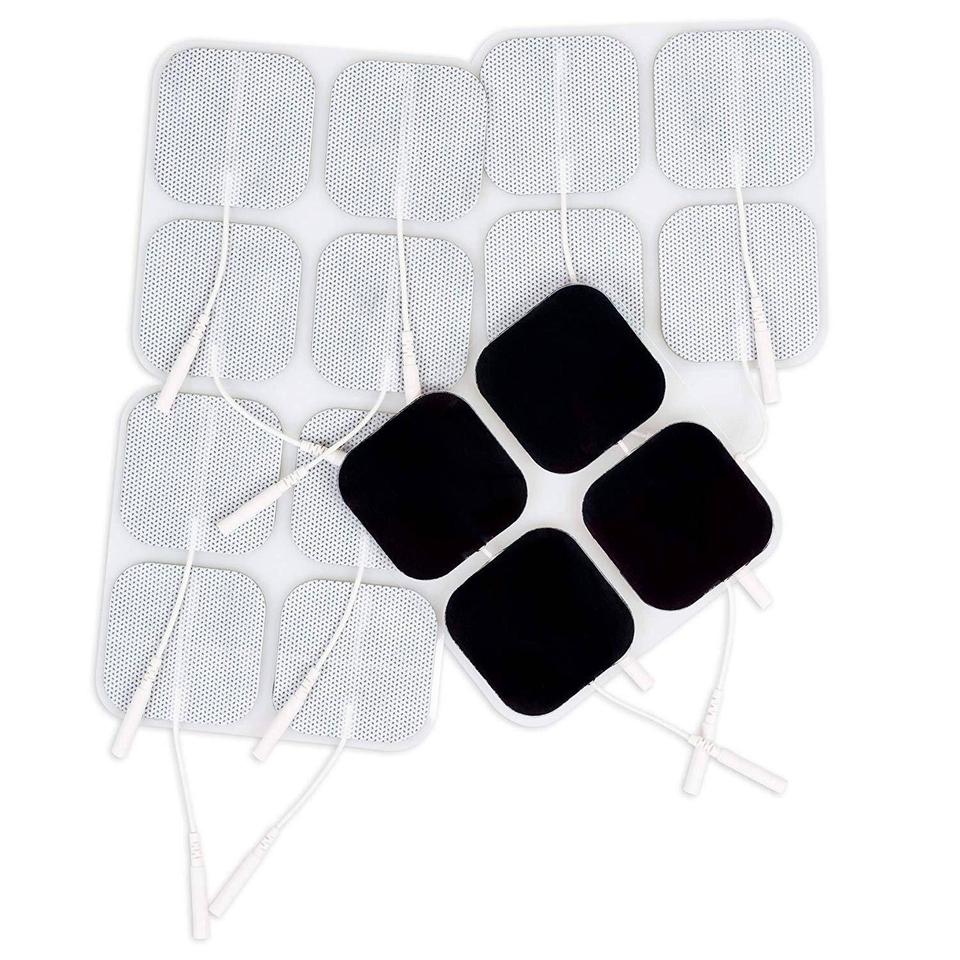
Not all pads are created equal, with some having a higher quality stick that lasts longer.
Some TENS units come by themselves, while others come with a carrying case, added electrodes, specialized equipment, and more.
Adding to the features and price are units that act as TENS/EMS combos. These units bring the benefit of TENS and EMS units while adding more to the cost. A simple TENS unit should work fine if you only need pain relief.
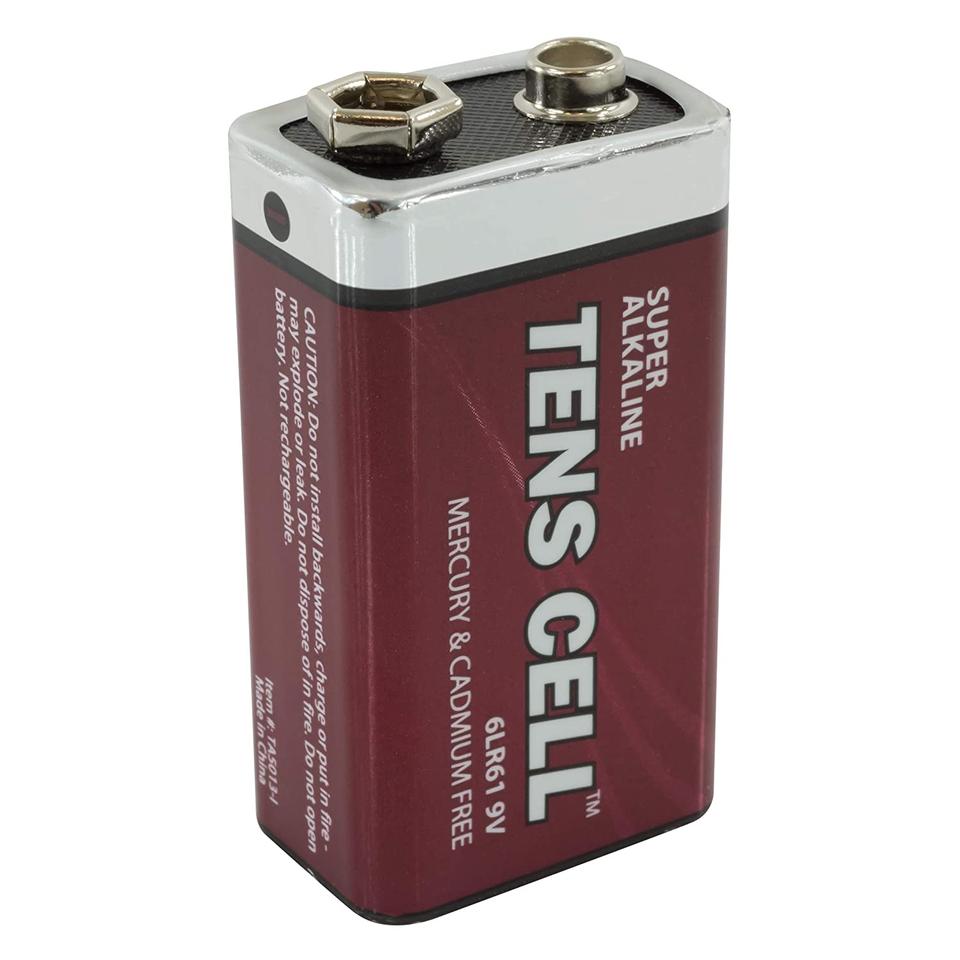
Some TENS units use rechargeable lithium batteries, while others use traditional batteries such as AAA or 9V.
We’d be lying if we said that the brand of the TENS unit does not play a role in selecting a TENS machine. Some TENS units have been around for over ten years, while others are relatively new. This factor is essential when choosing a TENS unit, as reliability is essential when managing pain.
Selecting the correct TENS unit is essential, considering pain can substantially impact your life. View all of the factors listed above to choose the correct TENS unit for you and centered around your preferences/needs.
There is no definite answer to this question as it will vary based on the type and location of the pain. We always advise you to start on the lowest level and slowly intensify the settings until you feel no pain. Do not turn it all the way up, as this may result in significant discomfort.
Yes! OTC TENS units often offer the same strength of pain relief as those prescribed by doctors. TENS units were once only available through healthcare professionals, but today, they are available without a prescription.